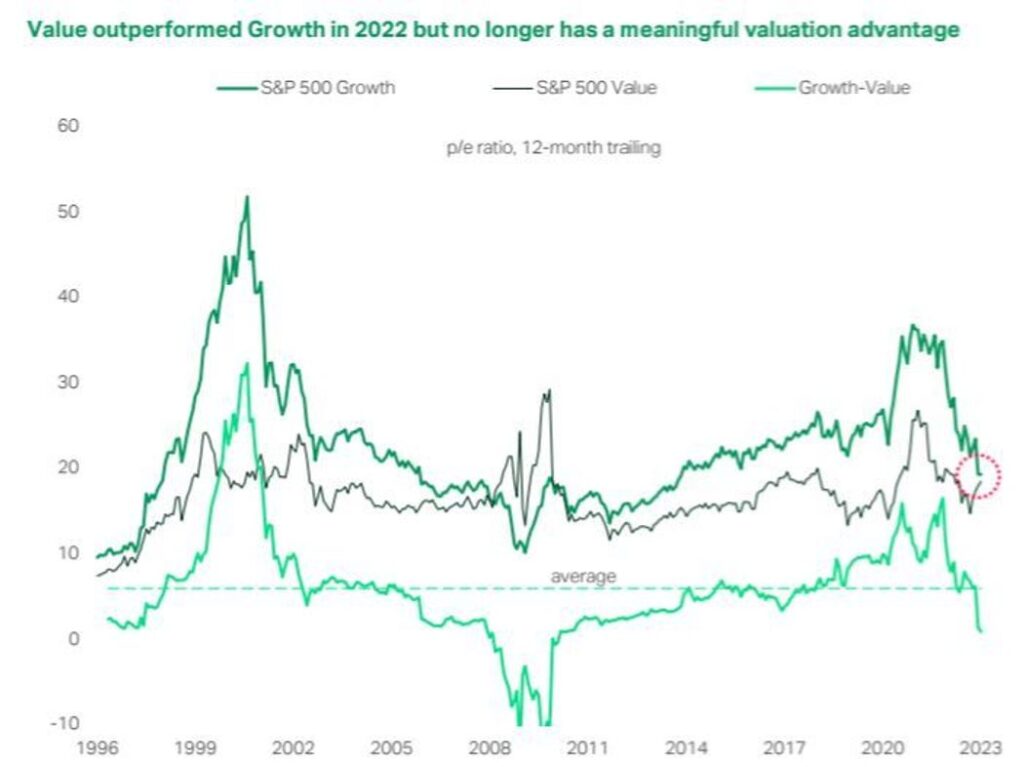Assuming that the current crisis or recession is temporary and merely an interruption in the upward trend in the U.S. stock market that has been going on for many years, one should buy U.S. stocks soon, but be very selective.1
Behind us lies a year of a bear market, in which the word inflation was king in the media. By the end of last year, however, inflation had already subsided, giving way in the media to the ominous recession that is now on everyone’s lips. Historically, recessions have always been the best time to buy stocks, and the ideal time to buy stocks is in the middle of a recession. Therefore, in our opinion, the long-term investor should already be on the lookout for opportunities in the overvalued sectors and build up their positions on a regular basis.
In which sectors could there be great potential? In our opinion, such a search should start with the sectors that have been hit the hardest recently and are currently out of favor with investors. With this in mind, consider the growth sector (growth companies) of the U.S. equity market.
Growth companies are characterized by above-average growth in sales, profits and operating cash flow, as well as high profit margins and a high return on invested capital. In their case, the current valuation of the stock is of secondary importance and the most important factor is the positive outlook for further growth in the parameters responsible for the company’s profitability.
Examples of growth sectors are all new and scalable technologies such as cybersecurity, data services, e-commerce, e-sports, artificial intelligence, genetics, biotechnology, telemedicine, robotics and automation, as well as any other part of the economy that has emerged in the recent past and is represented by companies such as Netflix, Uber, Tesla or Zoom.
When examining the long-term trend of the S&P Pure Growth Index, it turns out that not only is this index in a strong uptrend, but moreover, it is currently within one standard deviation of that trend. This results in an expected annual return of 17% over a five-year period. This should allow us to actually double our capital over the period under consideration, so we should focus our attention on this area.
The index’s direct competitor, the S&P Value Index, offers a potential return of only 4.9% per year over a five-year period using this methodology. Value means value, i.e. established companies that have a firm position in the market. Currently, almost half of the global value index is accounted for by the finance, healthcare and so-called industrial (i.e., providers of products and services to businesses) sectors. It is worth noting here in passing that some companies move from sector to sector, as in the case of Google (once Growth, now Value). Value are companies characterized by relatively low valuation ratios such as price/earnings, price/book or high dividend yields. As a result, the value sector currently enjoys almost all the attention of analysts and investors, as it has suffered minimal losses in the current bear market, which is why funds in this sector are currently experiencing record inflows. So, in our view, there are few opportunities here and we should rather turn to Growth’s selected sectors, such as the lately a bit forgotten sector of Biotechnology. Based on the long-term trend of the S&P Biotechnology Select Industry Index, this index calculates a potential annual return of up to 28% over a five-year period. This is based on the historically strong trend of this index of nearly 15.5% and a current record deviation from trend of 2.3 standard deviations. In other words, the index would need to gain almost 70% to return to its long-term trend. Is this possible? We have not been able to find a fact that could put an end to the growth and development of the biotechnology sector. We are not specialists in this field, but it is hard to deny the potential of areas such as genetics. Biotechnology is definitely a sector we will keep an eye on, even if a collapse comes to the markets.
Find more inspiration for your investments in our bulletin.

Ratio of Value to Growth is shown by the light green line below.
1 Sources for this article: Marketwatch, Investopedia, The Motley Fool, Morningstar.




